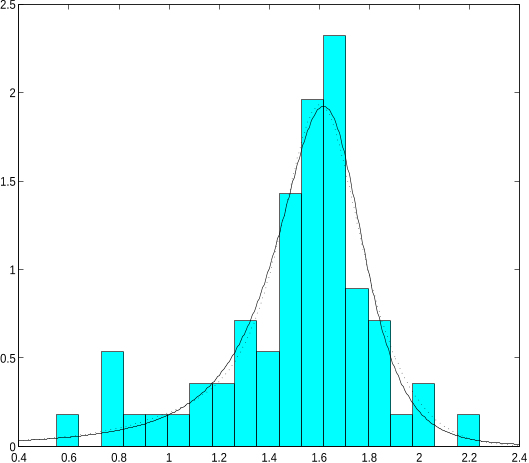













1 citations
1 citations
...Since then, several authors have tried to extend these results to more general forms of skew-symmetric distributions, of which here we would like to mention [9], in this paper; they proposed a general framework of distributions which is called flexible skewsymmetric (FSS) distribution....
[...]
...In this paper, with the adoption of a sufficiently flexible class of distributions, we consider one of these extensions, referred to as the family of flexible skew-symmetric (FSS) distributions which is introduced by [9] with the following density function of type: f (y; μ, ω,α) = 2ω −1 f 0 (z) G {P K (z)} , (1) where f...
[...]
1 citations
...For example, when w satisfies an anti-symmetric property, w(x;β,α) + w(x;β,α) = 1 for all x ∈ R, Copas and Li (1997), Arnold and Beaver (2002), Azzalini and Capitanio (2003), Ma and Genton (2004), Wang et al. (2004) and many others have described the types of selection mechanisms that lead to (1.1)....
[...]
1 citations
...Ma and Genton (2004) relaxed the normality assumption by using semiparametric generalized skew-ellipitical distributions....
[...]
1 citations
2,470 citations
...This representation has been used by Azzalini & Capitanio (2003) to define certain distributions by perturbation of symmetry....
[...]
...For K = 1, the pdf is always unimodal as was already noted by Azzalini (1985) for the univariate skew-normal distribution....
[...]
...The case K = 1 corresponds to Azzalini & Dalla Valle's (1996) bivariate skew-normal distribution, which cannot capture the bimodality....
[...]
...For K ¼ 1, the pdf is always unimodal as was already noted by Azzalini (1985) for the univariate skew-normal distribution....
[...]
...In particular, for ,il = ,B2 = /33 = & = 0, the pdf is exactly the bivariate skew-normal proposed by Azzalini & Dalla Valle (1996), and known to be unimodal (see Fig....
[...]
1,719 citations
1,478 citations
1,215 citations
...Finally, note that the stochastic representation of FSSdistributions follows from the stochastic representation of SS distributions described byWang et al. (2004), see also Azzalini & Capitanio (2003)....
[...]
...Similarly, multivariate distributions such as skew-t (Branco & Dey, 2001; Azzalini & Capitanio, 2003; Jones & Faddy, 2003; Sahu et al., 2003), skew-Cauchy (Arnold & Beaver, 2000) and other skewelliptical ones (Azzalini & Capitanio, 1999; Branco & Dey, 2001; Sahu et al., 2003) can be represented by…...
[...]
...Jones & Faddy (2003) and Azzalini & Capitanio (2003) fit two forms of skew-t distributions to these data....
[...]
...If each term has an odd order (all ks are odd), then the polynomial is called an odd polynomial, whereas if each term has an even order (all ks are even), it is called an even polynomial....
[...]